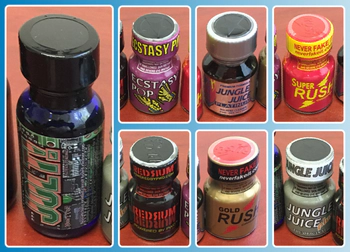What Are Poppers?
Drugs known as poppers have resulted in a surge in hospitalizations. The main mind-altering ingredient amyl nitrite causes blood vessels to expand, and its abuse can harm the heart.

In recent years, health care providers have reported a surge in hospitalizations related to the intentional ingestion or inhalation of nitrite products for recreational use. Such drugs, called “poppers,” are said to elicit physical and mental euphoria. And while popper drugs may appear to be just a simple, harmless liquid solution, these drugs are not harmless. Poppers create risks with a range of harmful side effects, including death.
Poppers Defined
The key ingredient that gives poppers their mind-altering effect is called amyl nitrite1 Amyl nitrate is a drug, a chemical composition that acts as a ‘vasodilator,’ meaning it expands the blood vessels. In the past, the drug was used as a medicine to treat chest pain brought on by oxygen deficiency in the heart muscle. The vasodilation effect of amyl nitrate was enough to expand blood vessels in the heart muscle and get more oxygen to the heart, thus reducing chest pain.

Courtesy of FDA.gov
Amyl nitrate is a clear, pale yellow liquid with a penetrating odor. When used for non-medical, recreational purposes, it is administered via inhalation and is rapidly absorbed into the body from the lungs. It affects many areas of the body beyond just the heart muscle, essentially relaxing multiple muscular systems throughout the body.
Poppers are often packaged in small bottles2 similar to energy shot beverages. They’re sold online, in adult novelty stores, and sometimes at convenience stores. They’re typically marketed as liquid incense, leather cleaners, cosmetics, solvents, “room odorizers,” or nail polish removers. But to incentivize users to buy them, manufacturers often ascribe compelling labels to popper bottles, like “Rush,” “Super Rush,” “Jungle Juice,” “Iron Horse,” and “Sub-Zero.”
Side Effects of Experimenting with Poppers
The list of harmful side effects caused by poppers continues to grow as the drugs become more popular. Following are some examples of the harm and health risks that can occur when people use poppers:
- When inhaled or consumed, the nitrites in poppers dilate the blood vessels in the body, resulting in a high or a “head-rush.”
- Because poppers lower blood pressure and increase heart rate, such drugs are particularly dangerous for people with heart conditions, abnormal blood pressure, anemia, or glaucoma.
- People who use poppers may experience headaches and nausea.
- Eye damage is a common side effect of popper experimentation.
- Popper abuse has been associated with a higher risk of contracting and transmitting blood-borne viruses. The drug increases the chance of tissue tearing during intercourse, making it easier for HIV and Hepatitis C to enter the bloodstream.
- Nitrites are also potential carcinogens. Prolonged popper usage may be linked with an increased risk of developing certain types of cancer.
- When mixed with other drugs, poppers can cause fainting, stroke, and even heart attack.
- Popper overdoses are rare, but they do occur. Further, overdoses on poppers can lead to organ failure due to a medical emergency condition called ‘methemoglobinemia.’ This is a condition in which the blood cannot carry oxygen around the body, leading to organ failure and even death.
- Other side effects of popper usage include severe headaches, throat irritation, nose bleeds, nausea, faintness, reduced breathing & heart rate, burns, blistering, weight loss, mouth or nasal sores, impaired smell, lung damage, anemia, and impaired cognitive function.
As mentioned above, poppers pose a health risk to users’ eyesight. Any person who uses poppers may experience this. To examine the risk to eyesight due to popper use, a global study was done to find out what percentage of users suffer some degree of lost eyesight. According to the research,3 about 2.2% of people who use poppers claim the drug damaged their eyesight, and at least 10% think it’s possible the drug harmed their ocular health. Beyond its detrimental effects on eyesight, it’s suspected poppers cause severe toxicity in other areas of the body, though such effects have not yet been fully studied.
Statistics and Popper Usage Trends
According to research published in the National Library of Medicine,4 about 3.3% of American adults have used poppers. As for usage trends, poppers are most frequently used by men within the LGBTQI+ community, particularly gay men. From the data, about 35% of gay men have used poppers, compared to 3.7% of heterosexual men.
“Often described as ‘a new way to use poppers’ or as ‘huffing poppers,’ in fact, the practice is simply huffing–that is, inhaling organic solvents or propellants…”
Another report highlighted the growing risk that when drug users “experiment with poppers” they might not actually be using poppers, they might be using something else instead. A group of researchers closely examined the chemical nature of substances used by people who thought they were using poppers. Their findings were illuminating. In the words of researchers Hall, Shoptaw, and Reback,5 “Often described as a ‘new way to use poppers’ or as ‘huffing poppers,’ in fact, the practice is simply huffing–that is, inhaling organic solvents or propellants. It does not involve conventional poppers, which are based on alkyl nitrites and are inhaled directly from a bottle, typically in smaller amounts. Huffing solvents and propellants carry substantially greater risk both for death and for long-term neurocognitive damage than does the use of nitrite poppers.” This newer trend of huffing that is being called popper experimentation could be of particular risk to new drug users; individuals who might be convinced by another user to experiment with a more dangerous inhalant.
Though the research literature on poppers is still limited, it is well known that the drug is dangerous. Further, it seems the trend of inhalant drug use and huffing has, in some ways, moved in on the popper trend, compelling drug users to branch out from popper experimentation into even more dangerous types of drug use.
Addiction to Poppers and the Need for Treatment
While poppers do not cause the type of physical dependence that many drugs do, poppers are addictive. People can become hooked on the sensations they experience while using poppers. Further, repeat drug use leads to tolerance, meaning users will have to take more of the drug to get the same effects from it. This puts them at greater risk of overdose. And finally, there is no guarantee that users are even using real poppers, as other inhalants and mind-altering substances are sometimes marketed as poppers.
Sources:
-
Britannica. “Amyl Nitrite.” brittanica.com ↩︎
-
BMJ. “The prevalence of visual symptoms in poppers users: a global survey.” 2017. bmjophth.bmj.com ↩︎
-
NIH. “Use of “Poppers” among Adults in the United States, 2015-2017.” 2020. ncbi.nlm.nih.gov ↩︎
-
NIH. “Sometimes Poppers Are Not Poppers: Huffing as an Emergent Health Concern among MSM Substance Users.” 2014. ncbi.nlm.nih.gov ↩︎





 ®
®